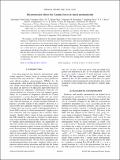| dc.contributor.author | McCauley, Alexander Patrick | |
| dc.contributor.author | Reid, M. T. Homer | |
| dc.contributor.author | Zhao, Rongkuo | |
| dc.contributor.author | Zhou, Jiangfeng | |
| dc.contributor.author | Rossa, F. S. S. | |
| dc.contributor.author | Dalvit, D. A. R. | |
| dc.contributor.author | Soukoulis, Costas M. | |
| dc.contributor.author | Rodriguez-Wong, Alejandro | |
| dc.contributor.author | Johnson, Steven G | |
| dc.contributor.author | Joannopoulos, John | |
| dc.date.accessioned | 2011-02-09T17:03:00Z | |
| dc.date.available | 2011-02-09T17:03:00Z | |
| dc.date.issued | 2010-10 | |
| dc.date.submitted | 2010-09 | |
| dc.identifier.issn | 1098-0121 | |
| dc.identifier.issn | 1550-235X | |
| dc.identifier.uri | http://hdl.handle.net/1721.1/60910 | |
| dc.description.abstract | We examine a recent prediction for the chirality dependence of the Casimir force in chiral metamaterials by numerical computation of the forces between the exact microstructures, rather than homogeneous approximations. Although repulsion in the metamaterial regime is rigorously impossible, it is unknown whether a reduction in the attractive force can be achieved through suitable material engineering. We compute the exact force for a chiral bent-cross pattern, as well as forces for an idealized “omega”-particle medium in the dilute approximation and identify the effects of structural inhomogeneity (i.e., proximity forces and anisotropy). We find that these microstructure effects dominate the force for separations where chirality was predicted to have a strong influence. At separations where the homogeneous approximation is valid, in even the most ideal circumstances the effects of chirality are less than 10[superscript −4] of the total force, making them virtually undetectable in experiments. | en_US |
| dc.language.iso | en_US | |
| dc.publisher | American Physical Society | en_US |
| dc.relation.isversionof | http://dx.doi.org/10.1103/PhysRevB.82.165108 | en_US |
| dc.rights | Article is made available in accordance with the publisher's policy and may be subject to US copyright law. Please refer to the publisher's site for terms of use. | en_US |
| dc.source | APS | en_US |
| dc.title | Microstructure effects for Casimir forces in chiral metamaterials | en_US |
| dc.type | Article | en_US |
| dc.identifier.citation | McCauley, Alexander P. et al. “Microstructure effects for Casimir forces in chiral metamaterials.” Physical Review B 82.16 (2010): 165108. © 2010 The American Physical Society. | en_US |
| dc.contributor.department | Massachusetts Institute of Technology. Institute for Soldier Nanotechnologies | en_US |
| dc.contributor.department | Massachusetts Institute of Technology. Department of Mathematics | en_US |
| dc.contributor.department | Massachusetts Institute of Technology. Department of Physics | en_US |
| dc.contributor.approver | Johnson, Steven G. | |
| dc.contributor.mitauthor | Johnson, Steven G. | |
| dc.contributor.mitauthor | Joannopoulos, John D. | |
| dc.contributor.mitauthor | McCauley, Alexander Patrick | |
| dc.contributor.mitauthor | Rodriguez, Alejandro W. | |
| dc.contributor.mitauthor | Reid, M. T. Homer | |
| dc.relation.journal | Physical Review B | en_US |
| dc.eprint.version | Final published version | en_US |
| dc.type.uri | http://purl.org/eprint/type/JournalArticle | en_US |
| eprint.status | http://purl.org/eprint/status/PeerReviewed | en_US |
| dspace.orderedauthors | McCauley, Alexander; Zhao, Rongkuo; Reid, M.; Rodriguez, Alejandro; Zhou, Jiangfeng; Rosa, F.; Joannopoulos, John; Dalvit, D.; Soukoulis, Costas; Johnson, Steven | en |
| dc.identifier.orcid | https://orcid.org/0000-0001-7327-4967 | |
| dc.identifier.orcid | https://orcid.org/0000-0002-7244-3682 | |
| mit.license | PUBLISHER_POLICY | en_US |
| mit.metadata.status | Complete | |
